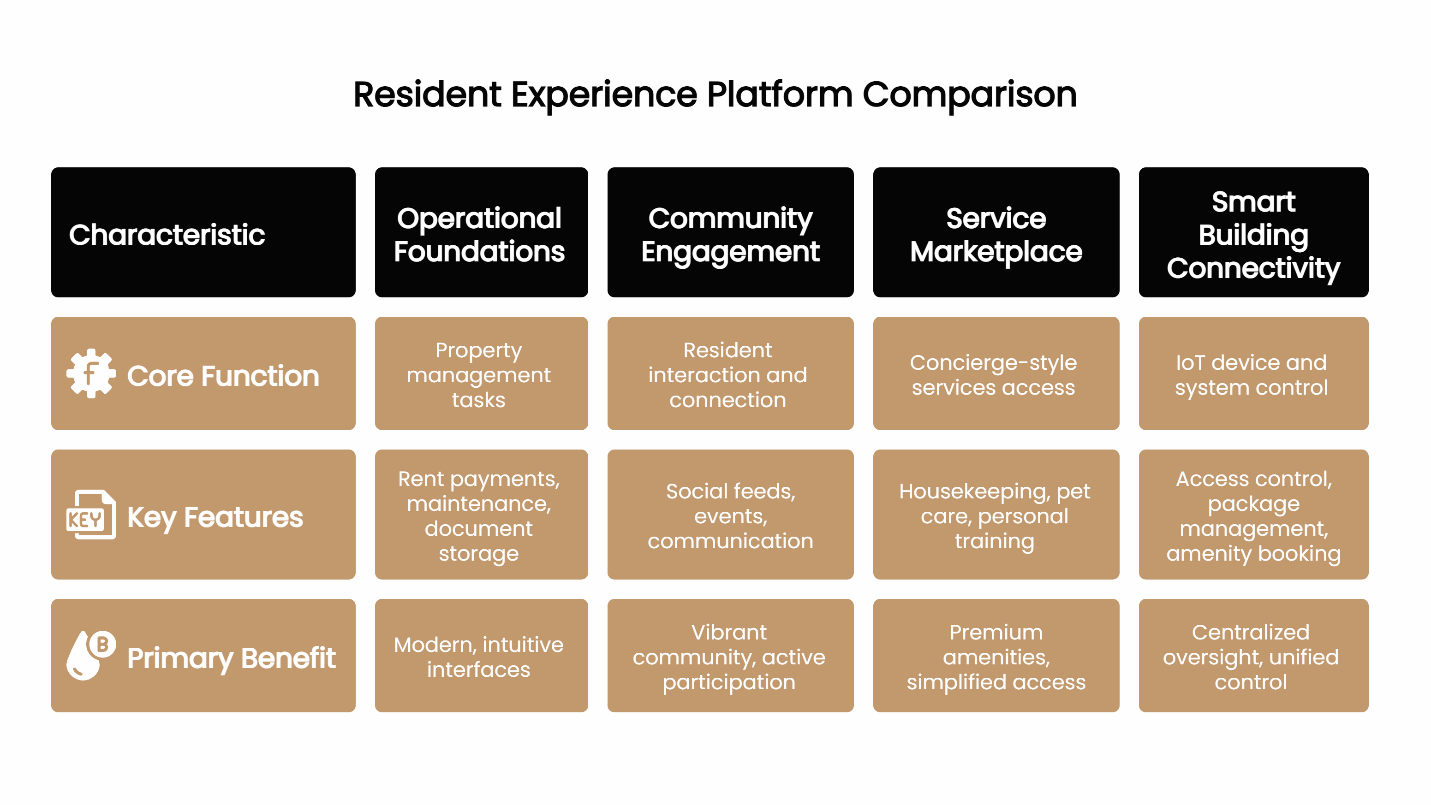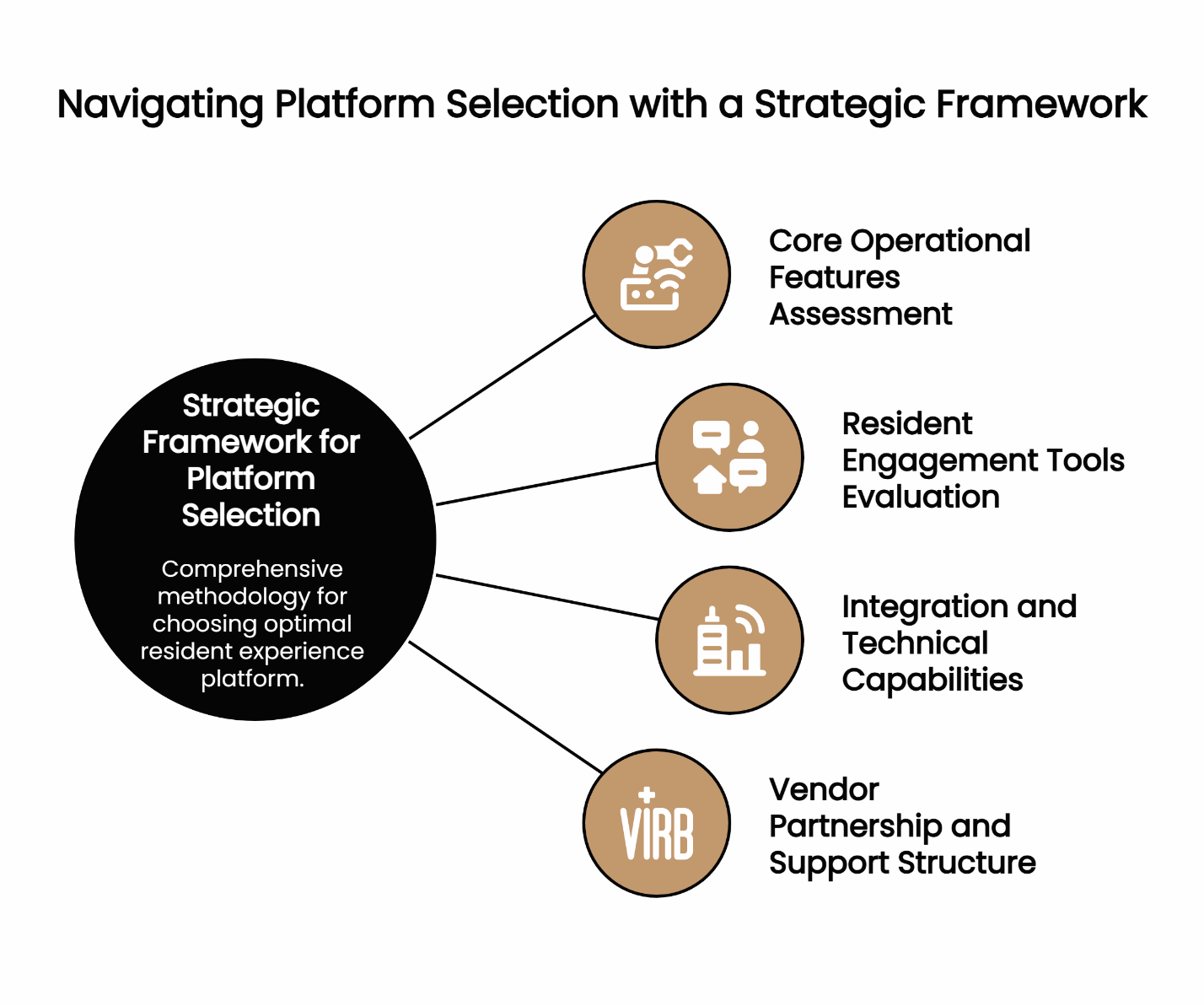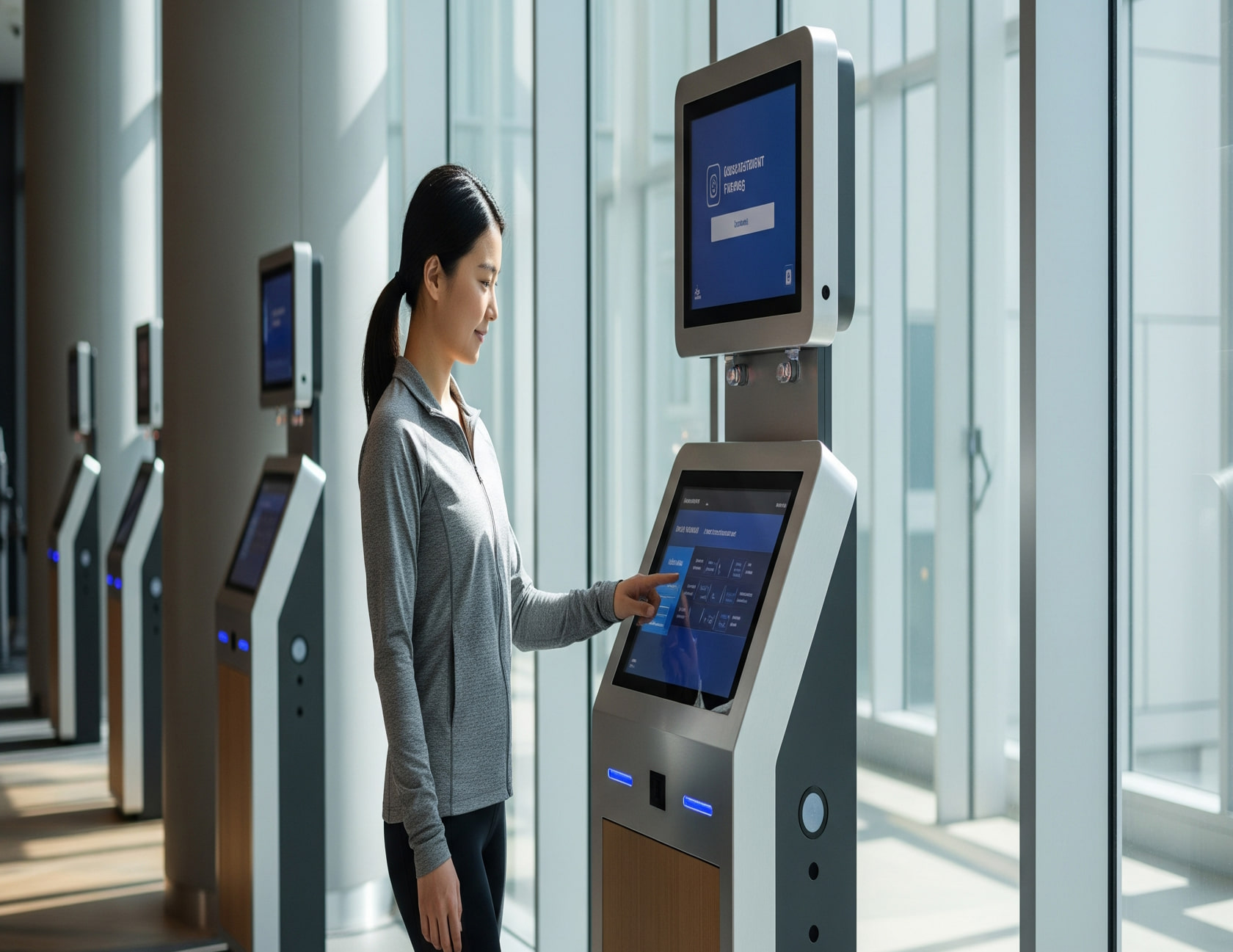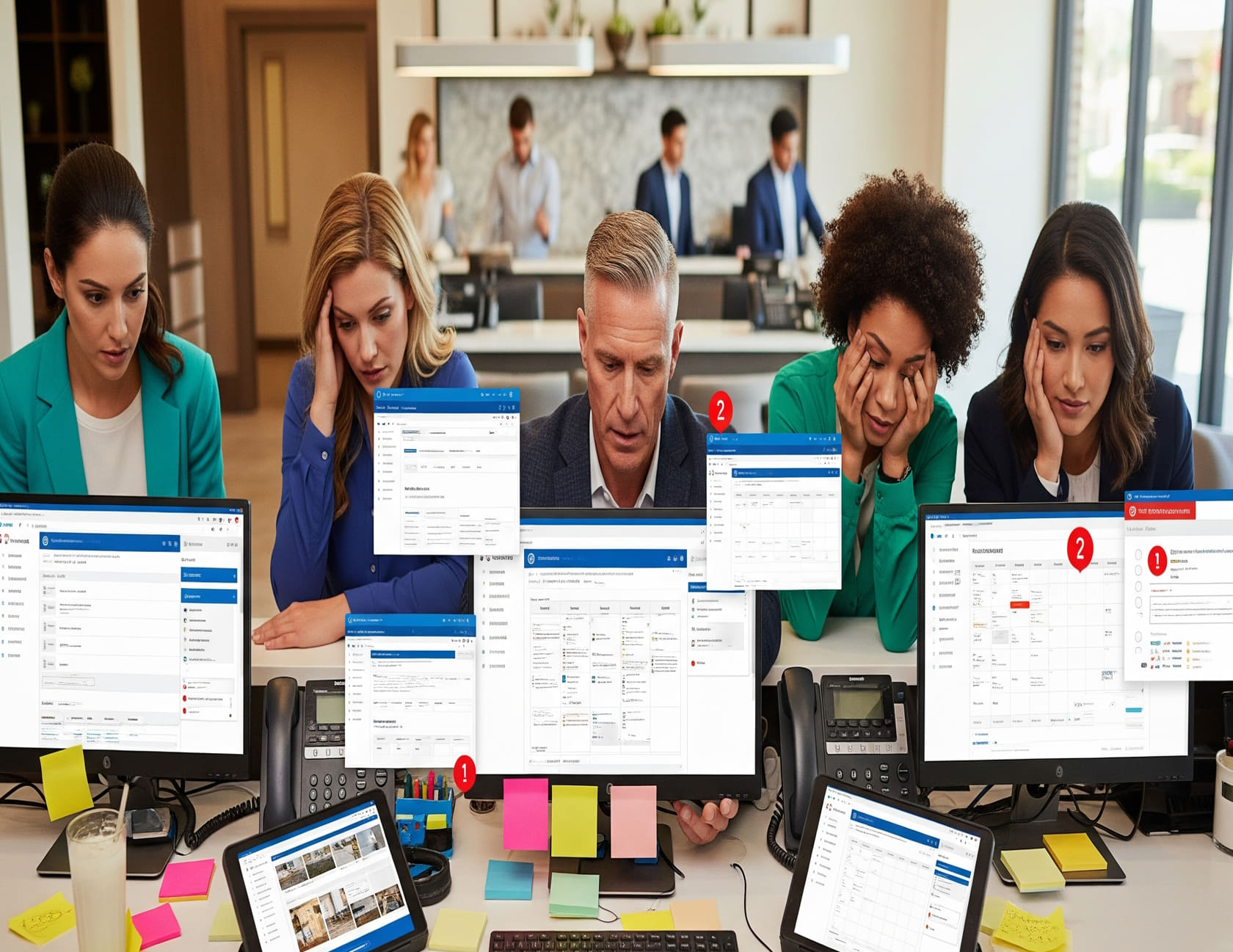
📌 Key Takeaways
The Experience Disconnect Creates Measurable Business Impact: Luxury multifamily properties face "App Fatigue" where residents juggle multiple apps for basic functions like rent payment, amenity booking, and maintenance requests, while property managers toggle between different vendor portals. This fragmentation undermines the luxury positioning Class A properties work to maintain and creates measurable operational inefficiencies including increased training time, higher support volumes, and reduced service adoption rates.
Unified Platforms Generate Tangible ROI Through Integration: A comprehensive Community Operating System consolidates all resident touchpoints into one branded, white-labeled experience that typically delivers substantial operational cost reductions, meaningful renewal rate increases, and revenue optimization through enhanced amenity utilization and new service offerings. Properties commonly report noticeable time savings on routine tasks and improved staff productivity within the first year of implementation.
Strategic Evaluation Requires Four-Dimensional Assessment: Successful platform selection demands systematic evaluation across core operational features (PMS integration, maintenance workflows), resident engagement tools (social feeds, service booking), technical capabilities (security protocols, building system connectivity), and vendor partnership quality (implementation support, long-term viability).
Stakeholder Alignment Determines Implementation Success: Platform adoption requires securing buy-in from diverse groups with different priorities - executives focus on strategic impact and ROI, IT teams need security assurances and integration details, operations staff require workflow improvements, and finance stakeholders evaluate total cost of ownership and contract terms.
Connected Communities Enable Data-Driven Optimization: Unified platforms position properties to leverage predictive analytics, AI integration, and IoT sensors for proactive experience optimization, transforming property management from reactive service delivery to strategic resident relationship management that compounds competitive advantages over time.
The comprehensive evaluation framework and consensus-building strategies outlined provide property managers with a systematic approach to eliminate app fatigue while enhancing operational efficiency and resident satisfaction in an increasingly competitive luxury multifamily market.
Table of Contents
- The Hidden Cost of Convenience: Identifying the "Experience Disconnect" in Your Community
- Beyond Apps: Defining the All-in-One Resident Experience Platform
- The Tangible Returns of a Unified System: Key Benefits for Class A Properties
- A Strategic Framework for Evaluating and Choosing the Right Platform
- Building Consensus: Gaining Stakeholder Buy-In for a Platform Transition
- Looking Ahead: The Future of the Connected Community
The Hidden Cost of Convenience: Identifying the "Experience Disconnect" in Your Community
The digital revolution promised to simplify operations and enhance resident experiences, but many luxuries multifamily communities now face an unexpected challenge: the more convenient tools they adopt, the more fragmented their operations become.
Walking through any Class A property today reveals a troubling reality. Residents juggle multiple apps to pay rent through one platform, book amenities through another, request maintenance via a third, and access building features through yet another system. Meanwhile, property management teams’ toggle between different vendor portals, struggle with data silos, and watch their operational efficiency decline despite significant technology investments.
This phenomenon represents what industry professionals call the "Experience Disconnect" – a fundamental misalignment between the luxury promise of seamless living and the reality of fragmented digital touchpoints. The disconnect manifests most clearly through "App Fatigue," where both residents and staff become overwhelmed by the sheer number of applications required for basic daily functions.
Business Impact App Fatigue creates measurable operational inefficiencies including increased training time for new staff members, higher support ticket volumes due to user confusion, and reduced adoption rates for valuable community services. Many properties report noticeable increases in time spent on routine tasks when managing multiple disconnected systems.
Consider the resident journey in a typical luxury community. Morning begins with checking one app for package notifications, another for fitness class schedules, and a third for community announcements. Booking the guest suite requires logging into a separate reservation system, while reporting a maintenance issue involves yet another platform. By evening, the same resident might use additional apps for concierge services or event RSVPs.
From an operational perspective, property managers face equally complex workflows. Maintenance requests arrive through one system while amenity reservations appear in another. Resident communication requires multiple platforms, and generating comprehensive reports means pulling data from numerous sources. Each additional vendor relationship introduces another point of potential failure and increases training requirements for staff.
The Experience Disconnect undermines the very luxury positioning that Class A properties work to maintain. When residents must navigate multiple interfaces to access basic services, the sophisticated lifestyle promise gives way to digital frustration. This disconnect between expectation and execution creates vulnerability in resident satisfaction scores and renewal rates.
Industry observations suggest that luxury consumers expect effortless experiences. When digital touchpoints create friction rather than convenience, the property's brand suffers. Residents begin viewing their community not as a premium lifestyle choice, but as a collection of disconnected services requiring constant navigation and management.
The fragmentation problem extends beyond user experience into strategic business concerns. Disconnected systems prevent comprehensive data analysis, making it difficult to understand resident behavior patterns or optimize service delivery. Property managers lose visibility into which amenities drive satisfaction, which services generate the highest engagement, and where operational bottlenecks occur.
Beyond Apps: Defining the All-in-One Resident Experience Platform

A unified resident experience platform represents a fundamental shift from managing multiple point solutions to orchestrating a comprehensive Community Operating System that integrates technology, services, and experiences under a single, cohesive interface.
This platform concept transcends traditional property management software by creating what many professionals describe as a "Lifestyle Layer" – an integrated ecosystem where operational functions, resident services, and community engagement tools work together seamlessly. Instead of asking residents to download separate apps for different functions, the platform consolidates all touchpoints into one branded, white-labeled experience.
The architecture of an effective platform encompasses four core integration areas. Operational foundations include traditional property management functions like rent payments, maintenance requests, and document storage, but presented through modern, intuitive interfaces that residents actually want to use.
Community engagement tools form the second pillar, featuring social feeds, interest groups, event management, and communication systems that foster genuine connections between residents. These tools transform apartments from mere housing into vibrant communities where neighbors know each other and participate actively in shared experiences.
Service marketplace integration represents the third component, bringing hotel-style concierge services directly into the resident experience. From housekeeping and pet care to personal training and spa services, residents access premium amenities without leaving their community app or managing relationships with multiple service providers.
Smart building connectivity completes the platform foundation, integrating access control, package management, amenity reservations, and IoT devices into a single control interface. Residents control their entire living environment through one application while property managers gain centralized oversight of all building systems.
Technical Note Modern platforms typically utilize API-first architecture enabling seamless integration with existing property management systems and building infrastructure. Security protocols generally include multi-factor authentication, encrypted data transmission, and role-based access controls that meet enterprise-grade requirements while maintaining user-friendly experiences.
The platform's strength lies not in individual features but in their interconnection. When a resident books a fitness class, the system automatically updates their calendar, sends preparation reminders, and offers related services like nutrition consultation or equipment rental. This level of integration creates experiences that feel magical to users while providing property managers with rich behavioral data.
Data unification represents another critical advantage. Instead of scattered information across multiple systems, property managers access comprehensive dashboards showing resident engagement patterns, service utilization rates, and operational metrics in real-time. This visibility enables proactive management decisions and creates opportunities for revenue optimization through targeted service offerings.
The white-labeling capability ensures that all resident interactions reinforce the property's brand instead of promoting third-party vendors. Residents see their community's logo, colors, and messaging throughout their digital experience, strengthening brand loyalty and creating the impression that all services are exclusive community amenities.
Platform implementation typically involves gradual migration instead of wholesale replacement of existing systems. Modern solutions integrate with current infrastructure, allowing properties to add unified functionality while maintaining operational continuity. This approach reduces implementation risk and enables phased rollouts that minimize disruption to daily operations.
The Tangible Returns of a Unified System: Key Benefits for Class A Properties
Properties implementing unified resident experience platforms typically observe improvements across five key performance areas: operational efficiency, resident satisfaction, brand differentiation, revenue generation, and strategic decision-making capability.
Streamlined Operations translate directly into reduced staff workload and improved service delivery. Property managers commonly report noticeable time savings when handling routine tasks through integrated workflows compared to managing multiple vendor relationships and disparate systems. Maintenance coordination becomes more efficient when requests, scheduling, and completion tracking occur within a single interface.
Enhanced Resident Engagement emerges as residents discover and utilize community services they previously overlooked. Unified platforms make amenities more visible and accessible, leading to higher utilization rates for fitness centers, community spaces, and social events. The convenience factor alone drives increased participation in community activities.
Elevated Brand Perception results from consistent, high-quality digital experiences that reinforce the property's luxury positioning. When residents interact with a polished, branded interface for all community services, their perception of the property's sophistication and attention to detail improves measurably.
Increased Revenue Opportunities develop through improved service delivery and expanded offerings. Properties can introduce new amenities and services more easily through the unified platform, while existing services become more profitable due to higher adoption rates and reduced operational overhead.
Data-Driven Decision Making becomes possible when comprehensive analytics replace fragmented reporting. Property managers gain insights into resident behavior patterns, service preferences, and community engagement trends that inform strategic planning and investment decisions.
Business Impact Properties utilizing unified platforms often report substantial operational cost reductions through decreased vendor management overhead, reduced training requirements, and improved staff productivity. Resident retention improvements are commonly observed, with many properties achieving meaningful renewal rate increases within the first year of implementation.
The operational benefits extend beyond immediate efficiency gains. Staff members require less training when working with integrated systems compared to learning multiple platforms. New team members become productive faster, and experienced staff can focus on high-value activities instead of navigating between different interfaces.
Resident satisfaction improvements typically manifest in multiple ways. Survey scores increase as daily interactions become more convenient and reliable. Maintenance response times improve when requests route efficiently through integrated workflows. Community participation rises when events and amenities become more discoverable and accessible.
The competitive advantage becomes particularly evident during leasing conversations. Prospective residents compare properties not just on physical amenities but on lifestyle convenience. Properties offering integrated digital experiences stand out in markets where competitors still rely on fragmented app ecosystems.
Revenue optimization occurs through several mechanisms. Enhanced amenity utilization increases income from fee-based services like guest suites, private dining spaces, and premium fitness facilities. New service offerings become viable when integrated delivery reduces operational complexity. Resident retention improvements reduce costly turnover and enable premium pricing for convenience.
Data insights enable proactive management strategies. Property managers identify underutilized amenities and adjust programming accordingly. Service usage patterns reveal opportunities for expansion or modification. Resident engagement metrics inform marketing strategies and community event planning.
The platform's ability to integrate third-party services creates additional revenue opportunities through partner relationships. Property managers can offer expanded service menus without direct operational responsibility, generating revenue sharing opportunities while enhancing resident convenience.
A Strategic Framework for Evaluating and Choosing the Right Platform

Selecting the optimal resident experience platform requires systematic evaluation across four critical dimensions that determine long-term success and stakeholder satisfaction.
The Unified Platform Evaluation Framework provides a comprehensive assessment methodology for property managers navigating platform selection decisions:
Core Operational Features Assessment
Property Management Integration
- Seamless connectivity with existing PMS systems
- Real-time data synchronization for rent payments, lease information, and resident communications
- Automated workflow capabilities for maintenance requests, move-in/move-out processes, and document management
- Comprehensive reporting and analytics dashboard integration
Essential Daily Functions
- Intuitive rent payment processing with multiple payment method support
- Efficient maintenance request submission and tracking with photo/video capabilities
- Secure document storage and sharing for lease agreements, community information, and important notices
- Robust communication tools for property management announcements and resident feedback
Resident Engagement Tools Evaluation
Community Building Features
- Social feed functionality for resident-to-resident interaction and community announcements
- Interest group creation and management for hobby clubs, fitness groups, and social activities
- Event planning and RSVP management with calendar integration and automated reminders
- Marketplace functionality for resident-to-resident buying, selling, and service sharing
Service Integration Capabilities
- On-demand service booking for housekeeping, pet care, personal training, and concierge services
- Amenity reservation system for community spaces, fitness facilities, and recreational areas
- Guest management features for visitor registration and temporary access coordination
- Package notification and management integration with delivery tracking
Integration and Technical Capabilities
Building System Connectivity
- Access control integration for keyless entry and visitor management
- Smart home device compatibility for thermostats, lighting, and security systems
- Package locker integration with automated notification and retrieval tracking
- Parking management system connectivity for space assignment and guest parking coordination
Data Security and Compliance
- Enterprise-grade security protocols with encryption and multi-factor authentication
- GDPR and privacy regulation compliance with transparent data usage policies
- Regular security audits and vulnerability assessments with documented procedures
- Disaster recovery and data backup systems with guaranteed uptime commitments
Vendor Partnership and Support Structure
Implementation and Training Support
- Comprehensive onboarding process with dedicated project management and timeline coordination
- Staff training programs with ongoing education and certification opportunities
- Resident communication support including marketing materials and adoption campaigns
- Technical support availability with guaranteed response times and escalation procedures
Long-term Partnership Viability
- Financial stability and growth trajectory of the platform provider
- Product development roadmap alignment with property management industry trends
- Reference customer availability and documented case studies with measurable results
- Contract flexibility and pricing transparency with clear upgrade and expansion pathways
Technical Note Successful platform integration generally requires API compatibility verification, data migration planning, and security protocol alignment with existing IT infrastructure. Properties should consider conducting pilot programs with select resident groups before full deployment to identify potential issues and optimize user adoption strategies. Integration timelines vary significantly based on system complexity and customization requirements.
The evaluation process should involve all key stakeholders from the beginning. Property managers focus on operational efficiency and resident satisfaction improvements. IT teams assess security, integration complexity, and ongoing maintenance requirements. Financial stakeholders evaluate total cost of ownership, ROI potential, and contract terms.
Platform selection success depends heavily on vendor responsiveness and support quality. Properties should evaluate not just current functionality but the provider's ability to evolve with changing resident expectations and technology advances. The ideal partner demonstrates consistent innovation while maintaining platform stability and security.
Day-to-Day Application Property managers using unified platforms commonly report significant reductions in time spent on routine administrative tasks, enabling focus on strategic initiatives like community programming, resident retention strategies, and revenue optimization. Daily workflows become more predictable and efficient when all resident interactions occur through integrated systems compared to multiple vendor platforms.
Reference checking becomes crucial during final selection. Speaking with current customers provides insights into real-world implementation challenges, ongoing support quality, and measurable business impact. Properties should specifically ask about user adoption rates, technical issues encountered, and overall satisfaction with vendor responsiveness.
Building Consensus: Gaining Stakeholder Buy-In for a Platform Transition
Platform adoption success depends on securing alignment across diverse stakeholder groups with different priorities, concerns, and success metrics.
Executive leadership typically focuses on strategic impact and financial returns. The business case for platform consolidation centers on operational efficiency gains, resident retention improvements, and competitive positioning advantages. Executives respond to clear ROI projections and risk mitigation strategies that demonstrate platform investment as a strategic necessity instead of a technology upgrade.
When presenting to C-Suite stakeholders, emphasize market positioning implications. Luxury multifamily properties compete on lifestyle convenience as much as physical amenities. Properties with fragmented digital experiences increasingly struggle to attract and retain residents who expect seamless technology integration in all aspects of their lives.
IT teams require detailed technical specifications and security assurances. Their primary concerns include data protection, system integration complexity, and ongoing maintenance requirements. Successful IT buy-in depends on demonstrating platform security credentials, integration capabilities, and vendor support quality.
Present IT stakeholders with comprehensive security documentation, including penetration testing results, compliance certifications, and data handling procedures. Address integration concerns by providing detailed API documentation and reference architectures from similar implementations. Emphasize vendor support responsiveness and technical expertise availability.
Operations staff focus on daily workflow improvements and training requirements. They need assurance that platform adoption will simplify compared to complicating their responsibilities. Operations buy-in develops through demonstration of workflow improvements and clear training pathway definition.
Finance stakeholders evaluate total cost of ownership, budget impact, and contract risk factors. They require transparent pricing models, clear implementation timelines, and detailed cost-benefit analysis. Financial approval depends on demonstrating platform investment as cost-effective compared to maintaining multiple vendor relationships.
Building consensus requires addressing specific stakeholder concerns proactively:
For Executive Stakeholders:
- Market research showing resident preference for integrated platforms over fragmented experiences
- Competitive analysis demonstrating platform adoption trends among comparable properties
- Strategic positioning arguments linking platform capabilities to brand differentiation
- Long-term vision for data-driven resident experience optimization
For IT Stakeholders:
- Detailed security architecture documentation with third-party audit results
- Integration testing results and reference implementations from similar properties
- Vendor technical support structure and response time commitments
- Data migration planning with rollback procedures and timeline definitions
For Operations Stakeholders:
- Workflow comparison showing current vs. future state process efficiency
- Training program structure with timeline and resource requirement details
- Change management support including resident communication assistance
- Success metrics definition with measurement methodology and tracking systems
For Finance Stakeholders:
- Total cost of ownership analysis comparing platform costs to current vendor expenses
- Implementation budget breakdown with contingency planning and milestone payments
- ROI projections based on documented results from comparable property implementations
- Contract terms analysis including termination clauses, upgrade policies, and pricing protection
The consensus-building process benefits from phased decision making. Begin with preliminary vendor demonstrations for the core evaluation team. Progress to detailed pilot program proposals for expanded stakeholder review. Final approval becomes easier when stakeholders participate in solution development instead of simply reviewing completed recommendations.
Creating a formal evaluation committee with representatives from each stakeholder group ensures all perspectives receive consideration during vendor selection. This committee structure also facilitates communication and builds ownership for the final decision across all affected departments.
Documentation throughout the evaluation process provides transparency and builds confidence in the decision-making methodology. Stakeholders feel more comfortable supporting recommendations when they understand the analysis framework and evaluation criteria used to reach conclusions.
Looking Ahead: The Future of the Connected Community
The evolution toward unified platforms represents just the beginning of a broader transformation in how luxury multifamily properties leverage technology to create competitive advantages and deepen resident relationships.
Platform consolidation enables sophisticated data analytics that reveal resident behavior patterns, service preferences, and community engagement trends. Properties can identify which amenities drive satisfaction, which services generate the highest utilization, and where operational improvements create the greatest impact. This data-driven approach transforms property management from reactive service delivery to proactive experience optimization.
Predictive analytics capabilities emerge when platforms accumulate sufficient historical data. Property managers can anticipate maintenance needs, forecast amenity demand, and identify residents at risk of non-renewal. These insights enable proactive interventions that prevent problems instead of simply responding to them after they occur.
The connected community concept extends beyond individual properties to neighborhood and city-wide integration. Platform providers increasingly offer partnerships with local businesses, service providers, and entertainment venues. Residents access exclusive deals and experiences through their community app, creating additional value while generating revenue opportunities for properties.
Artificial intelligence integration represents the next frontier for platform evolution. AI-powered chatbots handle routine resident inquiries, automated scheduling optimizes amenity utilization, and machine learning algorithms personalize service recommendations based on individual resident preferences and behavior patterns.
Smart building technology continues advancing platform capabilities. Internet of Things (IoT) sensors provide real-time data on space utilization, environmental conditions, and equipment performance. This information feeds platform analytics, enabling optimization of everything from HVAC settings to fitness center equipment placement.
The platform foundation positions properties to adopt emerging technologies as they mature. Virtual reality community tours, augmented reality amenity guides, and voice-controlled service requests become possible when underlying infrastructure supports seamless integration.
Sustainability initiatives benefit from platform integration through energy usage monitoring, waste reduction tracking, and resident engagement in environmental programs. Properties can gamify conservation efforts, provide real-time feedback on resource consumption, and coordinate community-wide sustainability initiatives through unified communication channels.
Platform evolution continues toward increasingly sophisticated personalization. Machine learning algorithms analyze resident behavior to suggest relevant services, optimize communication timing, and customize interface layouts. Each resident's experience becomes unique while maintaining operational efficiency for property management teams.
The future connected community serves as a lifestyle platform instead of simply a housing provider. Residents rely on their community app for local recommendations, exclusive experiences, and social connections. This deeper integration creates stronger emotional bonds and reduces likelihood of relocation when lease terms expire.
Property managers who embrace platform thinking position their communities for long-term competitive advantage. The investment in unified systems pays dividends through improved resident satisfaction, operational efficiency, and strategic decision-making capability that compounds over time.
As the multifamily industry continues evolving, properties with sophisticated platform infrastructure will attract and retain residents more effectively than those relying on fragmented systems. The Experience Disconnect that frustrates residents today becomes tomorrow's competitive differentiator for forward-thinking property managers.
Ready to transform your community's resident experience through platform unification?
The strategic advantages of consolidated systems become more pronounced as resident expectations continue rising. Properties that act decisively to address the Experience Disconnect position themselves for sustained success in an increasingly competitive market.
The comprehensive evaluation framework and stakeholder alignment strategies outlined above provide the foundation for successful platform selection and implementation. Schedule a demo to explore how a unified resident experience platform can eliminate app fatigue while enhancing your property's operational efficiency and resident satisfaction.

.avif)


